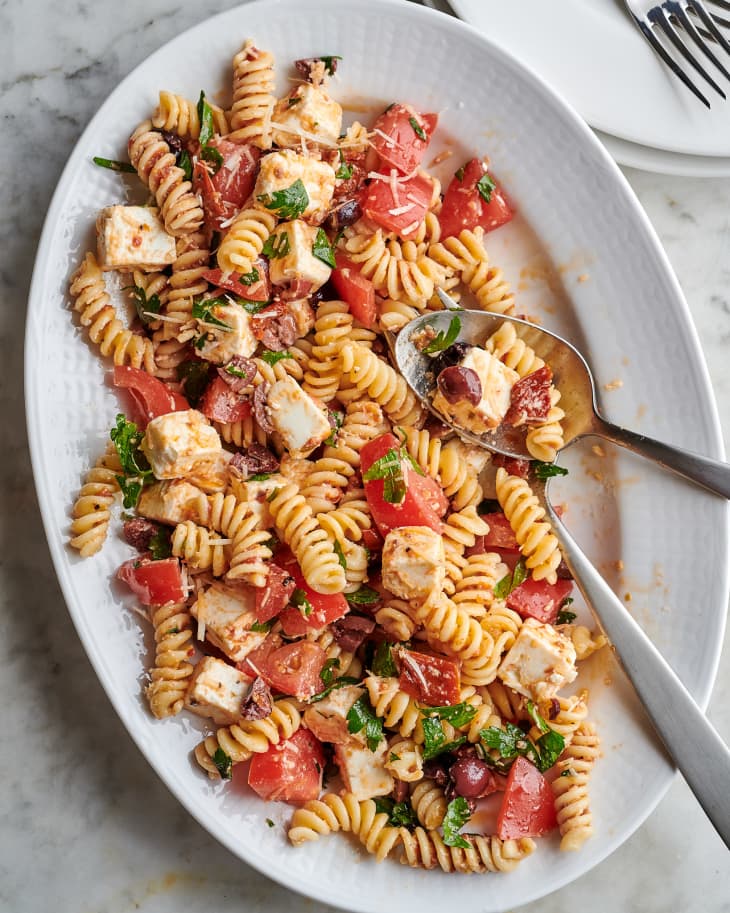I’ve Perfected Making Pasta Salad — These Are the 5 Tricks I Swear By
I love what summer cookout buffets reveal about our deepest desires: There are those people who can crush hot dog after hot dog like they’re competing in their own private contest, or the ones who load up their plates with banana pudding as though the rule of dinner-before-dessert has been waived, or the folks for whom the plate-buckling side dishes are the trues star of the show. I fall into the latter camp, in the subgroup of eaters who always make a b-line for the pasta salad.
As a kid in the kitchen, pasta salad was one of the first recipes I ever “perfected” (tri-color rotini, Good Seasonings dressing, cherry tomatoes, blanched broccoli, and feta), and I’d proudly tote it to family gatherings all summer long, usually sitting very close to it during the festivities to make sure it was being properly enjoyed.
These days, I’m still a fan, and, after many pasta salads consumed, I’ve gained some valuable wisdom from the sad, dry, under-dressed pasta salads that people politely shuffled around their plates before ditching. Here are my top five lessons learned on the long road to pasta salad success.
5 Tips for the Best Pasta Salad
1. Pay attention to the pasta.
Choose the right shape: A great pasta salad starts with great pasta, so it’s important to choose a shape that’s going to do exactly what you want. Elbows, shells, and orecchiette are popular because they’re bite-sized and great for cozying up to the other ingredients in the bowl, their curves cupping each cherry tomato and chunk of cheese. I also love pasta with ruffly edges, like campanelle, cascatelli, and, my all-time favorite, radiatorre (and of course, the pasta that started it all for me, rotini). Those ridges are made for harboring sauce and dressings, and they’re objectively fun to eat.
Salt the pasta water: Once you’ve landed on a shape, it’s essential to treat it right. This can’t be the first time you’ve heard us say to salt your water like the sea, but here, where the pasta will be eaten cold, it’s even more important because cold food always veers a bit toward the bland. Thus, it’s paramount to season at every step, beginning with the pasta water.
Cook it enough: When it comes to actually cooking the pasta, you want to take it a step beyond al dente — not mushy, but lacking any toothsomeness that you might look for when serving pasta hot, with sauce. That’s because this pasta will firm up as it cools, and if your pasta is already on the other side of al dente, it’s going to feel tough after a few hours in the fridge.
2. Dress while warm.
Resist the urge to hose down your just-cooked pasta with water until it’s ice cold, and instead, give it a quick rinse and then dress it immediately after draining while it’s still warm. This will allow the pasta to absorb the sauce, soaking up the flavor and getting luxuriously silky from the oil. (Ina Garten uses a similar trick for grain salads.)
But you’re not done dressing yet! Reserve some dressing for serving, giving the pasta salad another toss when it comes out of the fridge.
3. Use more oil than vinegar.
I love a bracingly acidic vinaigrette for leafy green salads, but for pasta salad, it’s important to use a light touch when it comes to the acidic ingredients, especially vinegar. As the pasta salad sits, the vinegar begins to take on a metallic aftertaste that’s, I’m almost certain, not what you’re going for. Amp up the good-quality oil and other flavor boosters, like whole grain mustard, anchovies, or pesto instead.
4. Add juicy ingredients.
Because pasta salad wants to dry out as it sits, I like to load mine up with secret, juicy weapons — ingredients that deliver both flavor and moisture (think: olives, capers, pickles, and peppers). These can help build flavor (zippy! Briny! Spicy!) and textural appeal without messing with the integrity of the pasta the way vinegar and lemon juice would.
5. Dress twice and serve at room temperature.
We think of pasta salad as a cold dish, and that’s true, it’s colder than your average pasta. But pasta salad straight from the fridge just tastes … cold. If you’ve followed all these tips — choosing the perfect pasta, treating it properly, and dressing it lovingly — trust me when I say you should give it a few minutes to knock the chill off before serving. Take that time to give your pasta salad another glug or two of dressing and a shower of fresh herbs, and the final product will be the kind of pasta salad that people invite you to parties hoping you’ll bring. (Just take care that it’s not getting too warm for too long, which increases the risk of foodborne illness — food shouldn’t sit at room temp for more than two hours.)
